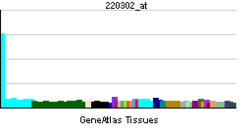MAK (gene)
| View/Edit Human | View/Edit Mouse |
Serine/threonine-protein kinase MAK is an enzyme that in humans is encoded by the MAK gene.[3][4]
The product of this gene is a serine/threonine protein kinase related to kinases involved in cell cycle regulation. It is expressed almost exclusively in the testis, primarily in germ cells. Studies of the mouse and rat homologs have localized the kinase to the chromosomes during meiosis in spermatogenesis, specifically to the synaptonemal complex that exists while homologous chromosomes are paired. There is, however, a study of the mouse homolog that has identified high levels of expression in developing sensory epithelia so its function may be more generalized.[4]
References
- ↑ "Human PubMed Reference:".
- ↑ "Mouse PubMed Reference:".
- ↑ Ma AH, Xia L, Desai SJ, Boucher DL, Guan Y, Shih HM, Shi XB, deVere White RW, Chen HW, Tepper CG, Kung HJ (Sep 2006). "Male germ cell-associated kinase, a male-specific kinase regulated by androgen, is a coactivator of androgen receptor in prostate cancer cells". Cancer Res. 66 (17): 8439–47. doi:10.1158/0008-5472.CAN-06-1636. PMID 16951154.
- 1 2 "Entrez Gene: MAK male germ cell-associated kinase".
Further reading
- Koji T, Jinno A, Matsushime H, et al. (1993). "In situ localization of male germ cell-associated kinase (mak) mRNA in adult mouse testis: specific expression in germ cells at stages around meiotic cell division". Cell Biochem. Funct. 10 (4): 273–9. doi:10.1002/cbf.290100411. PMID 1473268.
- Matsushime H, Jinno A, Takagi N, Shibuya M (1990). "A novel mammalian protein kinase gene (mak) is highly expressed in testicular germ cells at and after meiosis". Mol. Cell. Biol. 10 (5): 2261–8. PMC 360573
 . PMID 2183027.
. PMID 2183027. - Taketo M, Jinno A, Yamaguchi S, et al. (1994). "Mouse Mak gene for male germ cell-associated kinase maps to chromosome 13". Genomics. 19 (2): 397–8. doi:10.1006/geno.1994.1082. PMID 8188277.
- Jinno A, Tanaka K, Matsushime H, et al. (1993). "Testis-specific mak protein kinase is expressed specifically in the meiotic phase in spermatogenesis and is associated with a 210-kilodalton cellular phosphoprotein". Mol. Cell. Biol. 13 (7): 4146–56. PMC 359964
 . PMID 8321219.
. PMID 8321219. - Bladt F, Birchmeier C (1993). "Characterization and expression analysis of the murine rck gene: a protein kinase with a potential function in sensory cells". Differentiation. 53 (2): 115–22. doi:10.1111/j.1432-0436.1993.tb00651.x. PMID 8359591.
- Xia L, Robinson D, Ma AH, et al. (2002). "Identification of human male germ cell-associated kinase, a kinase transcriptionally activated by androgen in prostate cancer cells". J. Biol. Chem. 277 (38): 35422–33. doi:10.1074/jbc.M203940200. PMID 12084720.
- Strausberg RL, Feingold EA, Grouse LH, et al. (2003). "Generation and initial analysis of more than 15,000 full-length human and mouse cDNA sequences". Proc. Natl. Acad. Sci. U.S.A. 99 (26): 16899–903. doi:10.1073/pnas.242603899. PMC 139241
 . PMID 12477932.
. PMID 12477932. - Mungall AJ, Palmer SA, Sims SK, et al. (2003). "The DNA sequence and analysis of human chromosome 6". Nature. 425 (6960): 805–11. doi:10.1038/nature02055. PMID 14574404.
- Ota T, Suzuki Y, Nishikawa T, et al. (2004). "Complete sequencing and characterization of 21,243 full-length human cDNAs". Nat. Genet. 36 (1): 40–5. doi:10.1038/ng1285. PMID 14702039.
- Fu Z, Larson KA, Chitta RK, et al. (2007). "Identification of Yin-Yang Regulators and a Phosphorylation Consensus for Male Germ Cell-Associated Kinase (MAK)-Related Kinase". Mol. Cell. Biol. 26 (22): 8639–54. doi:10.1128/MCB.00816-06. PMC 1636783
 . PMID 16954377.
. PMID 16954377.
This article is issued from Wikipedia - version of the 6/2/2016. The text is available under the Creative Commons Attribution/Share Alike but additional terms may apply for the media files.
